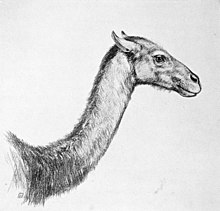Aepycamelus
Unlike earlier species of camelids, they possessed cushioned pads like those of modern camels.
[4] Aepycamelus was formerly referred to the genus Alticamelus, which Matthew (1901) erected for "Procamelus" altus Marsh, 1894, a camel species described from a calcaneum found in Neogene deposits in Oregon, after he referred a complete skeleton of a tall camel from Colorado to that species.
Matthew and Cook (1909) erected Alticamelus giraffinus for the Colorado specimen after recognizing the A. altus holotype as indeterminate.
It is presumed to have moved about singly or in small groups, like today's giraffes, and like them, browsed high up in the trees.
It survived a relatively long time, through most of the Miocene epoch, and died out prior to the start of the Pliocene, possibly due to climatic changes.

